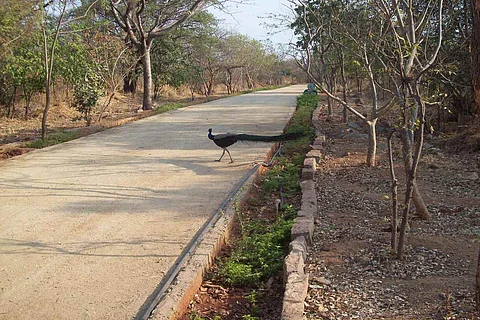

The Ministry of Environment, Forest and Climate Change (MoEFCC) has approved the Telangana government’s plan to reduce the width of the walkway of Kasu Brahmananda Reddy (KBR) National Park, located in the heart of Hyderabad, to facilitate the construction of six flyovers. This, despite severe opposition from activists over the last six years, who have been urging the government to reconsider the move, as it would result in trees being axed in the national park, which is spread over 360 acres.
The walkway garden which lies along the perimeter of the national park, identified as a “eco-sensitive zone” with a width of 25-30 meters, would be reduced to 3-25 meters, as per the MoEFCC notification issued on October 27.
In 2015, the Telangana government had proposed to construct flyovers, underpasses and multi-level grade separators as part of its Strategic Road Development Plan (SRDP) for better traffic management. Six junctions were to be developed at various locations, including KBR Park entrance, Jubilee Hills checkpost, Film Nagar junction, Jubilee Hills Road No. 45, Maharaja Agrasen junction (Banjara Hills Road No. 12) and Cancer Hospital junction (Banjara Hills Road No 10).
For this purpose, about 1400 trees surrounding the national park were to be either axed or translocated. However, environmentalists, activists and citizens who regularly go to the park for walking and jogging, had strongly objected to the government’s plan. They even approached the National Green Tribunal (NGT) challenging the Telangana government’s decision.
The latest development has shocked the activists who are part of the ‘Save KBR park’ movement. In February 2019, the MoEFCC had asked an expert committee “to explore the area and revise the ESZ (eco-sensitive zone) extent by allowing flyover under regulated activities and asked the state to submit a detailed report of the public hearing.”
Though the prerequisite public hearing was not conducted, the committee in a meeting held on August 18 claimed that the public hearing was conducted and the details of the meeting were “delayed due to the pandemic situation.”
Speaking to TNM, environmentalist Kaajal Maheshwari, who has been a vocal critic of the Telangana government’s plan and part of the ‘Save KBR park’ movement said, “The government has cheated the public. Earlier, they were very honest and transparent about the plans, but now without conducting a meeting, they claim to have done so, and have acquired the permission,” she lamented.
KBR park acts as a vast lung space for the rapidly-growing city and has a rich biodiversity. It is home to more than 600 plant species, 133 bird species, 20 mammal species and 20 species of reptiles and amphibians, as per the Forest Department. The major plant species are sandalwood, teak and neem while the major fauna found in the park include jungle cat, hare, porcupine, civets, pangolin, cobra, python, rat snake, star tortoise, geckos, monitor lizards, peacock, partridges, quails, owls and various species of butterflies.